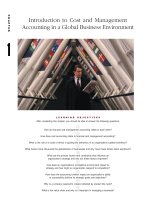Cost accounting chapter 14
Bạn đang xem bản rút gọn của tài liệu. Xem và tải ngay bản đầy đủ của tài liệu tại đây (1.96 MB, 28 trang )
Cost Allocation,
Customer Profitability Analysis,
and
Sales-Variance Analysis
© 2009 Pearson Prentice Hall. All rights reserved.
Cost Allocation
Assigning indirect costs to cost objects
These costs are not traced
Indirect costs often comprise a large
percentage of Total Overall Costs
© 2009 Pearson Prentice Hall. All rights reserved.
Purposes of Cost Allocation
© 2009 Pearson Prentice Hall. All rights reserved.
Six-Function Value Chain
Traditional Life Cycle approach may not yield the
costs necessary to meet the four-purpose criteria
for cost allocation
Costs necessary for decision-making may pull costs
from some or all of these six functions
(c) 2009 Pearson Prentice Hall. All rights reserved.
Criteria for Cost-Allocation Decisions
Cause and Effect – variables are identified
that cause resources to be consumed
Most credible to operating managers
Integral part of ABC
Benefits Received – the beneficiaries of the
outputs of the cost object are charged with
costs in proportion to the benefits received
© 2009 Pearson Prentice Hall. All rights reserved.
Criteria for Cost-Allocation Decisions
Fairness (Equity) – the basis for establishing a
price satisfactory to the government and its
suppliers.
Cost allocation here is viewed as a “reasonable” or
“fair” means of establishing selling price
Ability to Bear – cost are allocated in proportion
to the cost object’s ability to bear them
Generally, larger or more profitable objects receive
proportionally more of the allocated costs
© 2009 Pearson Prentice Hall. All rights reserved.
Cost Allocation Illustrated
© 2009 Pearson Prentice Hall. All rights reserved.
Corporate and Division Overhead Allocation Illustrated
© 2009 Pearson Prentice Hall. All rights reserved.
Customer Revenues and
Customer Costs
Customer-Profitability Analysis is the reporting
and analysis of revenues earned from
customers and costs incurred to earn those
revenues
An analysis of customer differences in
revenues and costs can provide insight into
why differences exist in the operating income
earned from different customers
© 2009 Pearson Prentice Hall. All rights reserved.
Customer Revenues
Price discounting is the reduction of selling prices
to encourage increases in customer purchases
Lower sales price is a tradeoff for larger sales
volumes
Discounts should be tracked by customer and
salesperson
© 2009 Pearson Prentice Hall. All rights reserved.
Customer Cost Analysis
Customer Cost Hierarchy categorizes costs
related to customers into different cost pools
on the basis of different:
types of drivers
cost-allocation bases
degrees of difficulty in determining cause-and-
effect or benefits-received relationships
© 2009 Pearson Prentice Hall. All rights reserved.
Customer Cost Hierarchy Example
1. Customer output unit-level costs
2. Customer batch-level costs
3. Customer-sustaining costs
4. Distribution-channel costs
5. Corporate-sustaining costs
© 2009 Pearson Prentice Hall. All rights reserved.
Other Factors in Evaluating Customer
Profitability
Likelihood of customer retention
Potential for sales growth
Long-run customer profitability
Increases in overall demand from having well-
known customers
Ability to learn from customers
© 2009 Pearson Prentice Hall. All rights reserved.
Customer Profitability Analysis Illustrated
© 2009 Pearson Prentice Hall. All rights reserved.
Customer Profitability Analysis Illustrated
© 2009 Pearson Prentice Hall. All rights reserved.
Customer Profitability Analysis Illustrated
© 2009 Pearson Prentice Hall. All rights reserved.
Customer Profitability Analysis Illustrated
© 2009 Pearson Prentice Hall. All rights reserved.
Sales Variances
Level 1: Static-budget variance – the
difference between an actual result and the
static-budgeted amount
Level 2: Flexible-budget variance – the
difference between an actual result and the
flexible-budgeted amount
Level 2: Sales-volume variance
Level 3: Sales Quantity variance
Level 3: Sales Mix variance
© 2009 Pearson Prentice Hall. All rights reserved.
Sales-Mix Variance
Measures shifts between selling more or
less of higher or lower profitable products
(c) 2009 Pearson Prentice Hall. All rights reserved.
Sales-Quantity Variance
© 2009 Pearson Prentice Hall. All rights reserved.
Flexible-Budget and Sales-Volume
Variances Illustrated
© 2009 Pearson Prentice Hall. All rights reserved.
Sales-Mix and –Quantity Variances
Illustrated
© 2009 Pearson Prentice Hall. All rights reserved.
Market-Share Variance
© 2009 Pearson Prentice Hall. All rights reserved.
Market-Size Variance
© 2009 Pearson Prentice Hall. All rights reserved.
Market-Share and –Size Variances
Illustrated
© 2009 Pearson Prentice Hall. All rights reserved.









